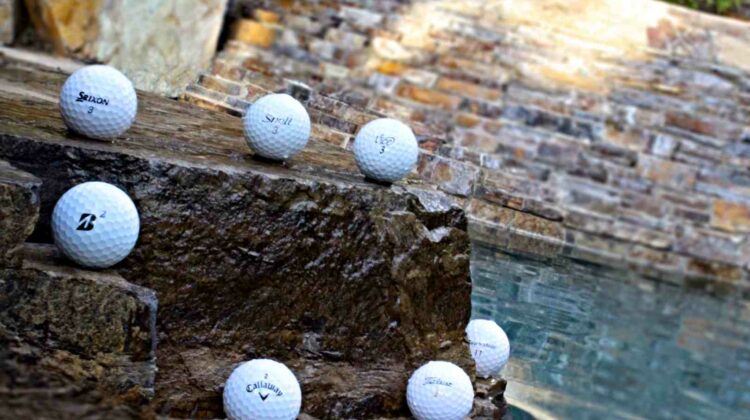
Golf ball brands are everywhere now. Because of this it’s hard to know what golf ball brand is best for you and your game. From the tried and true of companies like Titleist and Callaway, to new players like PXG and Vice, it can be difficult to peel back the curtain on what can make a difference in your game.
Unfortunately, there’s a plethora of options available and no one is to blame for being a little overwhelmed at the thought of trying to choose just one. After all, we don’t have sponsors telling us which ball to play. Well, at least I don’t.
The positive part of all our options is that each golf ball is designed and catered to different playing styles. Which means there is bound to be one that fits your game.
And your budget.
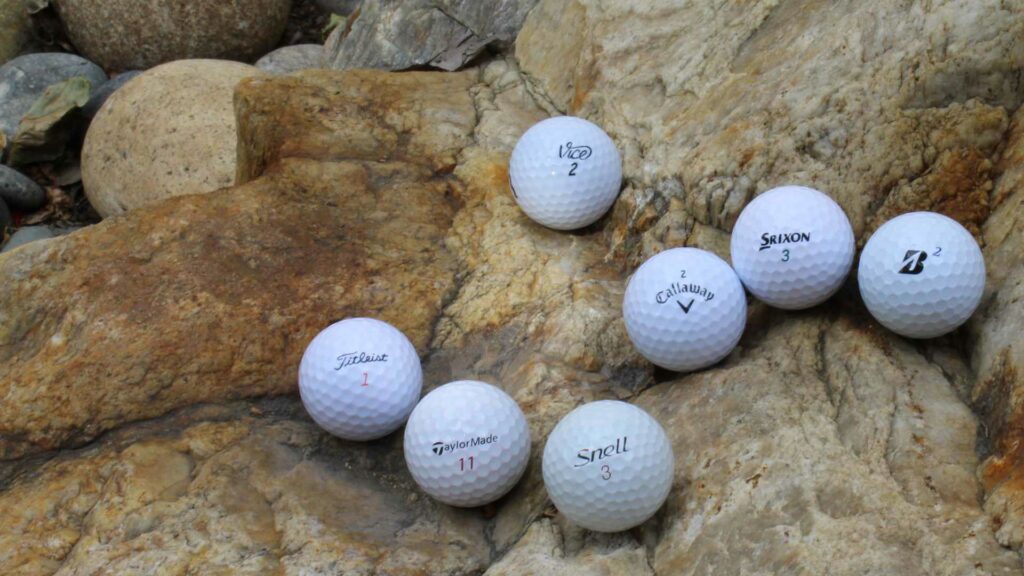
Where to Start
We don’t all have access to Trackman. Though it’d be nice if we did…
We’ve heard for decades about the importance of getting fit for your clubs, but what about your ball? This is a service pros get all the time, but it’s just now starting to make it mainstream for us mere mortals.
The process of selecting the right golf ball can have a deer-in-headlights effect, often akin to navigating a vast ocean of options. On this golf ball guide alone, there are over 30 options.
Balancing factors such as swing speed, playing style, spin control, and overall performance can seem like juggling on a unicycle. But fear not! There’s more good news.
You don’t have to find the unicorn of a perfect ball. It doesn’t exist. Every ball is going to give something to get something. You just have to decide what performance is most important to you.
If you want some help with this, see this guide on choosing the right ball. But let me stress the importance of trying different balls!
Play the Same Ball on Every Shot
The step after choosing the right ball from the golf ball guide is actually playing it.
On every. Single. Shot.
We’re all guilty of it. But it kills our game. It can’t be stressed enough, if you want to play better golf, you NEED to play the same golf ball on every shot. No matter what.
I know, I’ve been there too. Just lost that third ball of a fresh new sleeve and now it’s time to dig out that cringy dirty ball you found in the woods. Been there, done that.
While my bank account would tell me that there’s still a time and a place for this to happen, my ache for lowering my handicap disagrees.
Feel is overrated
In the realm of golf ball guide tools, the emphasis on “feel” is often overstated. Though this is starting to change in recent years.
While it’s true that a softer feel can provide a sense of confidence and comfort, especially around the greens, it’s important not to let it overshadow other critical performance factors.
For example, you can probably get used to a different feel, but it’s a whole lot harder to get used to spin characteristics that don’t fit your game. While feel certainly has its place, it should be considered part of the decision. Not the whole decision. And maybe not even a big part.
All that being said, without further ado, here is the complete golf ball guide to almost every ball out there…
OEM Golf Ball Brands (Original Equipment Manufacturers)
For those unfamiliar, these are the big dawgs of the golf ball brands. Deserving of their own golf ball guide breakdown. They have the biggest budgets, the biggest market shares, and the most recognizable names.
Let’s dive in.
Titleist Golf Balls: No Introduction Needed
Number 1 for a reason.
Competition in the golf ball space has been getting crowded lately. But that hasn’t stopped Titleist from maintaining its standard of excellence.
As new companies join the arms race, they’re proving that making a good golf ball is achievable. Challenging, but achievable.
The actual hard part is making that same great ball on repeat. That is where Titleist separates itself from the rest of the pack. Even in their less desirable golf ball options, their consistency remains tour-level quality. They are the golf ball that every other company measures itself against. And for good reason.
If we can’t trust a Titleist golf ball, what can we trust?
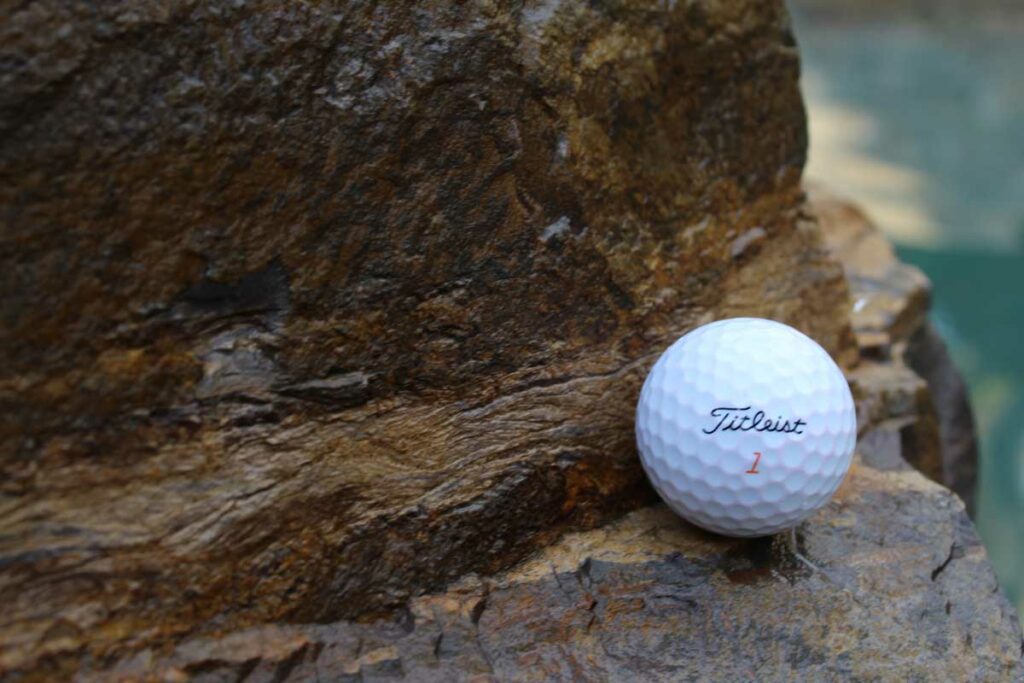
1. Titleist Pro V1
Your favorite ball’s favorite ball.
The Pro V1 is going to be pretty close to the middle of the pack when it comes to trajectory, speed, and spin.
This is by no means a knock on the Pro V1, quite the opposite in fact.
There’s a reason why it’s the first ball on this list.
I think it’s safe to say this is the gold standard of tour-quality golf balls. It has been for over 20 years and there doesn’t seem to be an end in sight.
No matter how fast you swing or how much spin you produce, the Pro V1 is going to provide a benefit to your game.
And if you have no idea what ball to start your search with, look no further than the Pro V1.
- Good for: All-around performance. Specifically golfers without extremely high or low swing speeds.
- Full Review: Titleist Pro V1 Review
- Construction: 3-piece
- Cover: Urethane
- Price: $55 – Shop Now
- Solid Alternative: Taylormade TP5x, Bridgestone Tour B X, Maxfli Tour
2. Titleist Pro V1x
The newest iteration of the Pro V1x has seen a seismic shift in the vortex of Titleist golf balls.
Known for launching higher and spinning more than the Pro V1, the two balls have seemingly switched places on the spin matrix.
While the Pro V1 still hangs out around the average spin rate of premium golf balls, the Pro V1x now spins less than its close sibling.
Driver trajectory will still be higher with the Pro V1x but don’t expect the elite stopping power around the greens that it used to have.
This ball is built for speed and distance now.
The feel will be noticeably firmer than the Pro V1, but its urethane outer cover will still offer a soft feel on putts and short chips that we all love.
- Good for: High swing speeds. Golfers craving a little higher ball flight and more distance.
- Full Review: Titleist Pro V1x Review
- Construction: 4-piece (Dual Core)
- Cover: Urethane
- Price: $55 – Shop Now
- Solid Alternative: Srixon Z-Star XV, Callaway Chrome Soft X, Maxfli Tour X
3. Titleist Pro V1x Left Dash
Everybody’s favorite secret ball. For a long time, the Pro V1x Left Dash was tour pros-only territory.
Not anymore.
In recent years, Titleist made the Pro V1x Left Dash available to the masses and they’ve never looked back.
As you could probably guess, the Left Dash is constructed similarly to the Pro V1x with 4 layers, but the Left Dash plays with a little bit lower spin and flatter trajectory.
Thank almost a hybrid ball between the Pro V1 and Pro V1x as far as spin and trajectory are concerned.
Another big difference with the Left Dash is its increased firmness. One of the firmest balls in the entire golf ball market.
This increased firmness with lower spin should add a few extra yards when you need it most.
If you love the Pro V1x, I wouldn’t hesitate to give the Left Dash a try.
- Good for: Golfers looking for more distance.
- Fulll Review: Pro V1x Left Dash Review.
- Construction: 4-piece
- Cover: Urethane
- Price: $55 – Shop Now
- Solid Alternative: Callaway Chrome Soft X LS, Srixon Z-Star XV, Vice Pro Plus
4. Titleist Pro V1 Left Dot
The close cousin of the Pro V1, the “Left Dot” spent even longer on Titlest’s secret list than the Left Dash did.
The golf ball die-hards have finally gotten their wish as Titleist has now made them both available mainstream.
The Left Dot (literally shown as a dot to the left of a Pro V1 logo on the ball) will play similarly to a Pro V1 with the biggest difference coming by way of lower trajectory and less spin.
I will add a warning that this golf ball is not for everybody.
There’s a reason it wasn’t widely available for a long time.
For most of us mere mortals, we need help getting the ball off the ground and the Left Dot will do the exact opposite.
However, if you don’t have trouble hitting higher trajectories, this ball might be worth a try as it will give you the added bonus of less spin for those longer shots.
While the Left Dot seems closest to a Pro V1 by name, it’s also oddly similar to Titleist’s AVX option.
The biggest difference here is the Left Dot is much firmer so it will produce more ball speed than an AVX while giving a little extra spin around the greens.
- Good for: Pro V1 users who want a little less spin. AVX users who want a little more distance.
- Construction: 3-piece
- Cover: Urethane
- Price: $55 – Shop Now
- Solid Alternative: Titleist AVX, Titleist Pro V1, Callaway Chrome Soft
5. Titleist AVX
Perhaps the softest feeling ball in the elite Titleist lineup, the AVX is definitely not for the everyman.
However, there is a place in the market for its lower flight and softer feel.
Namely, if you have long been a Chrome Soft diehard and wondered what the Titleist comp would be, the AVX is it.
The two have almost identical readings on launch monitor data and you wouldn’t be shocked if you can’t tell the difference between the two.
The AVX is a bit of a unicorn when it comes to performance as it’s hard to pinpoint exactly who benefits most from its specs, but players with high swing speeds who are looking to take spin off their shots could be a great fit.
- Good for: Golfers wanting a soft ball with little spin.
- Full Review: Titleist AVX Review
- Construction: 3-piece
- Cover: Urethane
- Price: $55 – Shop Now
- Solid Alternative: Callaway Chrome Soft, Titleist Pro V1 Left Dot
6. Titleist Tour Speed
Titleist’s last of their Urethane cover balls brings us to the Tour Speed.
Not to be confused by its name, this ball does not find itself in Titleist’s tour lineup.
However, the Tour Speed’s performance is not a far cry from its big brother golf balls.
Off the tee, it performs almost identically to that of the Pro V1 group, which I think really says something about this ball.
On the other hand, the Tour Speed’s wedge play is where we see the difference between it and the elite Titleist balls. It will launch a little bit higher at shorter distances, but with so much less spin, it may not have the most stopping power.
If price is more of a factor for you than performance, this will be a great ball for you to put into play.
- Good for: Budget-conscious golfers who still want reliable performance.
- Full Review: Titleist Tour Speed Review
- Construction: 3-piece
- Cover: Urethane
- Price: $42 – Shop Now
- Solid Alternative: Taylormade Tour Response, Vice Pro
7. Titleist Tour Soft
There’s no two ways about it, the Tour Soft is Titleist’s best option in the “best of the rest” category.
The goal here is not elite performance and that’s ok. Not all of our goals are to be scratch golfers.
With that said, if you are going to buy a ball based on price instead of performance, you might as well buy it from the kings of the golf ball game.
- Good for: Golfers who want a soft feel and are less concerned about premium performance.
- Construction: 2-piece
- Cover: Ionomer
- Price: $37 – Shop Now
- Solid Alternative: Bridgestone e12
Bridgestone Golf Balls: Options For Everyone
Bridgestone was the first to offer a full lineup of premium balls.
From fast swing speeds to Average Joes, Bridgestone has a ball in their repertoire that will fit your game.
You just have to find it.
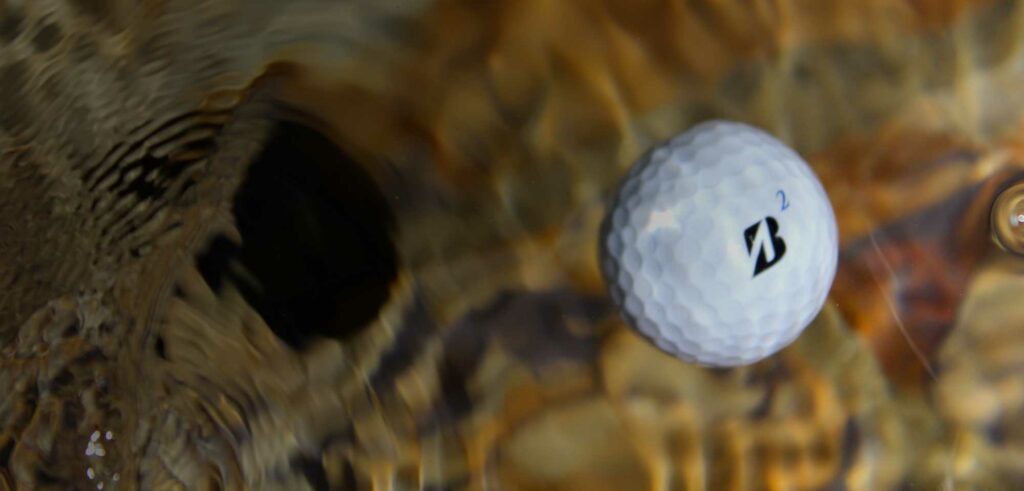
1. Bridgestone Tour B X
One of my favorite balls on the market!
Bridgestone offers one of the most unique visual differences of any golf ball on the market as their balls all have a distinct “dual dimple” design.
When it comes to the Tour B X, it leads the Bridgestone repertoire in the way of firmness.
Not the firmest ball out there, but certainly in the conversation of the highest-compression golf balls.
The Tour B X also has one of the highest trajectories of the Bridgestone balls which I believe is pretty evident in the times I’ve played it.
As far as spin, the wedge spin is not quite as grippy as the Tour B XS but still ranks among the elites when it comes to greenside spin.
It’s worth noting that Bridgestone boasts the Tour B X as a ball for players who swing over 105 MPH.
For what it’s worth, I barely flirt with this speed on the low side and it’s still one of my favorites.
- Good for: All-around performance with an emphasis on short game spin.
- Construction: 3-piece
- Cover: Urethane
- Price: $50 – Shop Now
- Solid Alternative: Titleist Pro V1, Taylormade TP5x
2. Bridgestone Tour B XS
For the Tiger lovers out there.
That’s right the exclusive ball of Tiger Woods is the Tour B XS which means Tiger had A LOT of say in what went into its design.
As far as balls actually played on tour, it’s on the softer side, though I wouldn’t consider it a truly soft ball. It tends to hover in that middle ground area for firmness.
It is by far the spinniest of the Bridgestone balls and, in my opinion, is very noticeable.
Side story: One day I was out playing a round, thought I pulled out a Tour B X to play with. On the first green, I had a chip that stopped about 5 feet short of what I expected. In my befuddlement, I picked up the ball only to notice it was a B XS.
That said, I don’t play it as often because I don’t love how the extra spin can sometimes spray my irons right and left too much.
But if you love some workability and can control your spin, this is one of the most elite balls out there.
After all, the best player of our generation practically designed it.
*Should also note Bridgestone recommends the Tour B XS for players with swing speeds over 105 MPH just like the Tour B X.
- Good for: Golfers who like workability and more spin. Or just Tiger lovers.
- Construction: 3-piece
- Cover: Urethane
- Price: $50 – Shop Now
- Solid Alternative: Srixon Z-Star XV, Titleist Pro V1x
3. Bridgestone Tour B RX
The next two balls in Bridgestone’s lineup come with the “R” designation which also means they are much softer than the Tour B X and XS.
Off the driver, you will probably be able to feel a slight difference in the firmness, but the real difference shows up on short game spin.
The spin on irons and wedges is significantly lower than B X or B XS golf balls, however, this iteration launches much higher.
This combination of lower spin with higher trajectory is the recipe for a few extra yards with the short clubs.
You might not have quite as much zip on the greens, but if you can get down with some bump-and-runs, this all will be right up your alley.
*Disclaimers are back again! Bridgestone only recommends the Tour B RX for swing speeds under 105 MPH.
- Good for: Slower swing speeds trying to maximize distance through lower spin.
- Construction: 3-piece
- Cover: Urethane
- Price: $50 – Shop Now
- Solid Alternative: Bridgestone Tour B RXS, Vice Pro Soft
4. Bridgestone Tour B RXS
Mark the Tour B RXS down as Bridgestone’s other ball for swing speeds under 105 MPH.
The RXS is by far the softest of the premium Bridgestone golf balls and is very noticeable throughout the bag.
It does tend to launch lower than most of the other options, especially off the tee.
But if you are after an extremely butter-soft feel with a high level of playability, look no further.
Other than a difference in firmness, it will play extremely similar to the B RX.
- Good for: Slower swing speeds who want a softer feel.
- Construction: 3-piece
- Cover: Urethane
- Price: $50 – Shop Now
- Solid Alternative: Bridgestone Tour B RX, Vice Pro Soft
Taylormade Golf Balls: Layers on Layers
The infamous brand that brought us the first five-layer ball.
I don’t know if more is always better, but it definitely adds more spin.
Taylormade’s golf ball options are fewer than their counterparts but lack nothing in the way of performance.
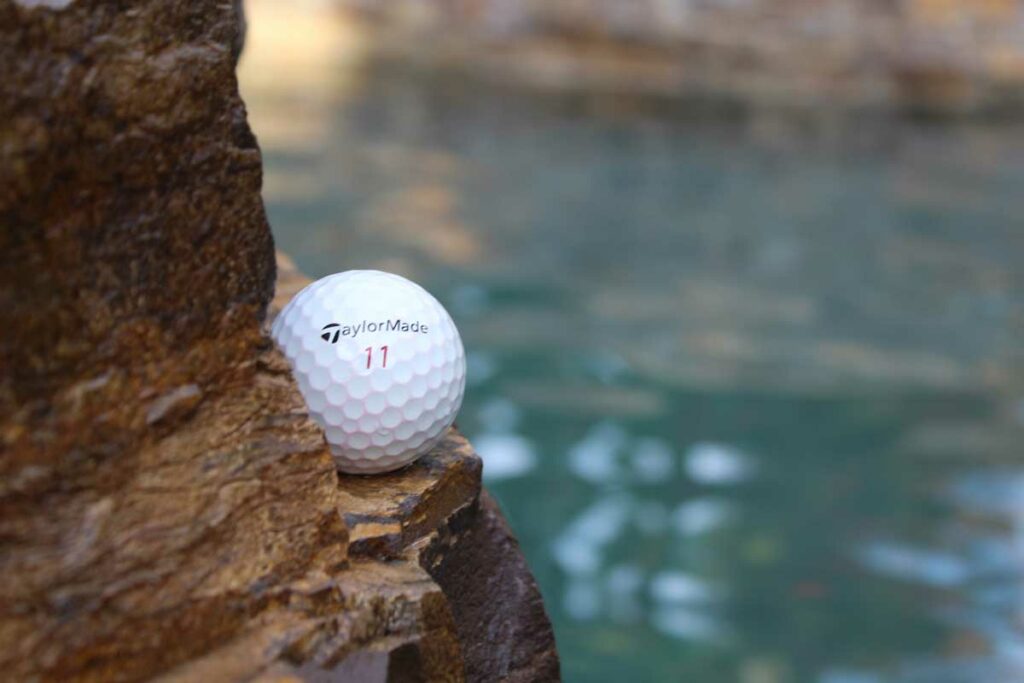
1. Taylormade TP5
Known for its 5-piece construction, the TP5 bills itself as the “control” ball of the Taylormade family.
It has a slightly softer feel than the TP5x but spins an incredible amount more. In fact, it’s one of the highest-spinning balls on the market.
I tried to play this ball for a while, but it just spun too much for me and made controlling those mid-irons too difficult when trying to work the ball.
However, if you struggle with getting spin on your ball, especially trying to get short wedge shots to stick on greens, the TP5 might be your ticket to greatness.
- Good for: Spin, spin, spin.
- Construction: 5-piece
- Cover: Urethane
- Price: $50
- Solid Alternative: Titleist Pro V1x, Callaway Chrome Soft X, Kirkland Performance+ v3.0
2. Taylormade TP5x
Just like its Taylormade sibling to the TP5x has a 5-piece construction.
With the TP5 being as soft as it is, it’s only natural that the TP5x falls on the firmer side of the scale. I think it’s safe to say its firmness is fairly average in compared to other manufacturers, but it’s the firmest that Taylormade offers.
Pair this added firmness with a slightly lower spin rate and the TP5x should lead itself to a little more distance off the tee for you than the TP5.
When it comes to comparison with other brands, the TP5x is still not in the lowest of the group but is much closer to the middle of the pack than the TP5.
- Good for: All-around performance.
- Construction: 5-piece
- Cover: Urethane
- Price: $50
- Solid Alternative: Titleist Pro V1
3. Taylormade Tour Response
The little brother of the Taylormade family plays like it’s got something to prove.
Tour Response still comes with the soft urethane cover that is commonplace in modern tour golf balls, so you are not losing any performance or feel from that standpoint.
However, comparing it to the other Taylormade options, the Tour Response doesn’t have nearly the same spin capabilities. Especially around the greens.
I think a more common (and fair) comparison is to the Titleist Tour Speed where the launch and spin characteristics match up pretty closely. But if you like soft, the Tour Response plays much softer than its Titleist competitor.
All in all, the Taylormade Tour Response offers a pretty good balance of performance with improved spin from previous models.
Given its price point, it is definitely toward my top recommendation of balls just below the premium tour-level options.
- Good for: Budget golfers that still want to pack a punch.
- Construction: 3-piece
- Cover: Urethane
- Price: $43
- Solid Alternative: Titleist Tour Speed, Vice Pro
4. Taylormade Soft Response
The Soft Response is exactly that, the softest of the Taylormade golf ball options.
Part of this is aided by its ionomer cover which adds a softer feel. Taylormade also inserted an extremely soft core which lowers the compression even further.
The Soft Response still has a 3-piece construction unlike other brands’ ionomer covered balls which definitely adds a little bit to its performance capabilities, but this ball is still not going to compete with any of the big boys.
If you are coming across this ball, it’s because you want a solid ball for your weekend game that’s not going to break the bank.
- Good for: Soft-feel players who are less concerned with elite performance.
- Construction: 3-piece
- Cover: Ionomer
- Price: $30
- Solid Alternative: Titleist Tour Soft
Callaway Golf Balls: Call it a Comeback
Callaway has some very documented struggles when it comes to golf balls.
Inconsistent construction, off-center cores, and other struggles riddled their lineup for much longer than they would have liked.
However, a massive financial commitment and a few new additions to their repertoire and Callaway seems to have put their issues behind them.
Oh, and they also make soft balls cool.
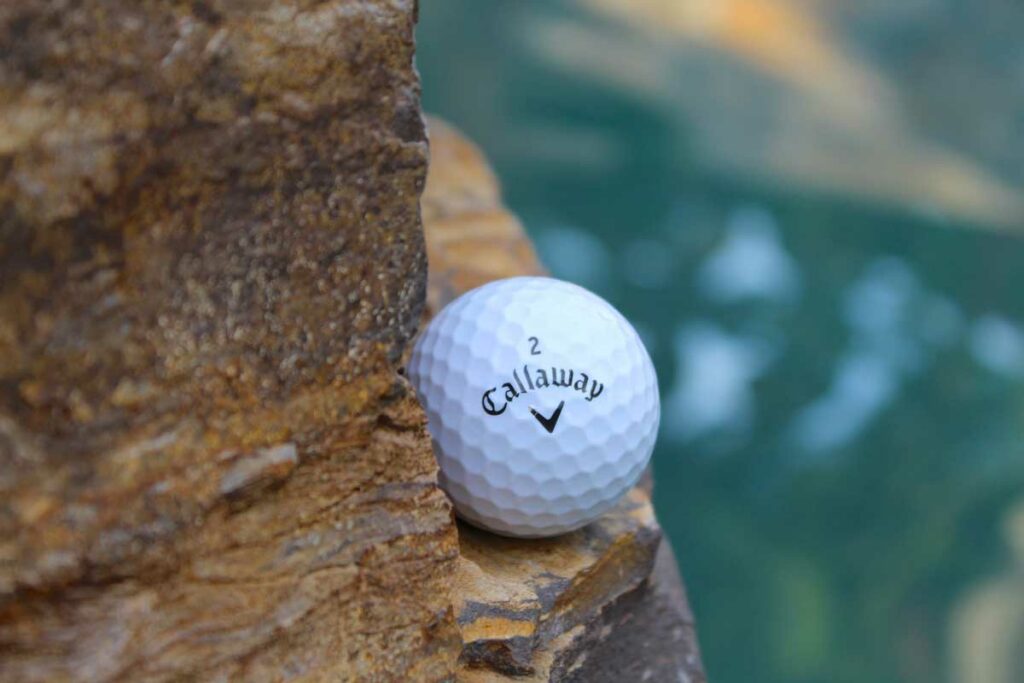
1. Callaway Chrome Soft
The ball that started a movement!
There were soft balls before the Chrome Soft, but we had never seen a tour ball like this before.
Callaway’s Chrome Soft comes in as one of the lowest, if not the lowest, compression golf balls that are marketed as a tour ball.
And let me tell you, it’s very noticeable.
In my experience, it took a certain amount of swings before I could truly start feeling different compression in golf balls.
But what was the ball that it finally clicked? Callaway Chrome Soft.
The Chrome Soft went through a bit of a change in its most recent iteration going from a 4-piece ball to a 3-piece and the result actually ended in an even softer ball.
Compared to other tour-level balls, Chrome Soft tends to launch out of a mid-to-low window and offers a pretty decent amount of spin, considering its softness.
While science has proven that softer balls lead to lower ball speed, the impacts are a bit overblown in my opinion.
Admittedly, I do not play a Chrome Soft, but if that buttery soft feel is something you covet then it still offers plenty of other strong benefits that warrant a trial.
- Good for: High-spin golfers who want a softer feel.
- Construction: 3-piece
- Cover: Urethane
- Price: $50 – Shop Now
- Solid Alternative: Titleist Pro V1 Left Dot, Titleist AVX
2. Callaway Chrome Soft X
My favorite of the Callaway golf ball family is definitely the Chrome Soft X.
Maybe I just like firmer balls. I’m starting to see a trend.
The Chrome Soft X is lightyears firmer than the Chrome Soft and is undoubtedly a response to some of the early knocks placed on the Chrome Soft for being too soft and not offering enough speed off the clubface.
This “X” version of the Chrome Soft offers a firmer feel and lower spin off the driver compared to its counterpart.
It still wouldn’t be my favorite ball in the marketplace, but the bounce and grab capabilities around the green are the real deal!
- Good for: Golfers who want to add distance and greenside spin.
- Construction: 4-piece
- Cover: Urethane
- Price: $50
- Solid Alternative: Titleist Pro V1x, Maxfli Tour X
3. Callaway Chrome Soft X LS
Simply put, it’s a ball that feels like a Chrome Soft X, but plays like a Chrome Soft around the green.
And before you ask, yes, the LS is for low spin.
Because it’s the firmest of the Callaway balls you will get the most distance out of it. Especially on longer shots.
Couple that with lower spin and this ball could be a game-changer if you need help finding fairways.
Just know that what you gain in long-game consistency will end up costing you in short-game spin.
Not a deal breaker by any means, just be ready for bump-and-runs rather than bounce and stop on the greens.
- Good for: Firmer feel golfers who want to find fairways.
- Construction: 4-piece
- Cover: Urethane
- Price: $50
- Solid Alternative: Titleist Pro V1x Left Dash
4. Callaway ERC Soft
This might be the most common ball I find when I’m looking for balls in unfamiliar places.
Maybe it’s the recognizable Callaway Triple Track that helps me see it, or maybe people everywhere are stocking up on them like another pandemic is coming.
Either way, I the ERC Soft is intriguing to a much higher degree than many probably realize.
The newest edition now boasts a hybrid (their word, not mine) cover layer that essentially wraps a layer of urethane around a layer of ionomer.
The thought here is that you can get more spin on shorter shots while maintaining a much lower spin rate on drives and long irons.
The effect is one of the most interesting golf balls in the group of golf balls right below elite tour balls.
I can’t say I’ve ever started a round with an ERC Soft as my ball of choice, but whenever I’m having a bad round and find one in the woods, it never lets me down.
The recent uptick in greenside spin will not put it in a spinning contest with the best spinning golf balls, but it will perform just like you need it to on those bump-and-run style shots.
- Good for: Budget golfers still looking for some performance.
- Construction: 4-piece
- Cover: Hybrid (Urethane coating on top of Ionomer)
- Price: $40
- Solid Alternative: Bridgestone B RXS, Vice Pro Soft
Srixon Golf Balls: The Best Ball You’ve Never Played
Ever seen a Srixon golf ball while you were out in the woods and wondered how it got there?
It was probably me.
A sleeper company when it comes to good golf balls. Everybody likes a good underdog story.
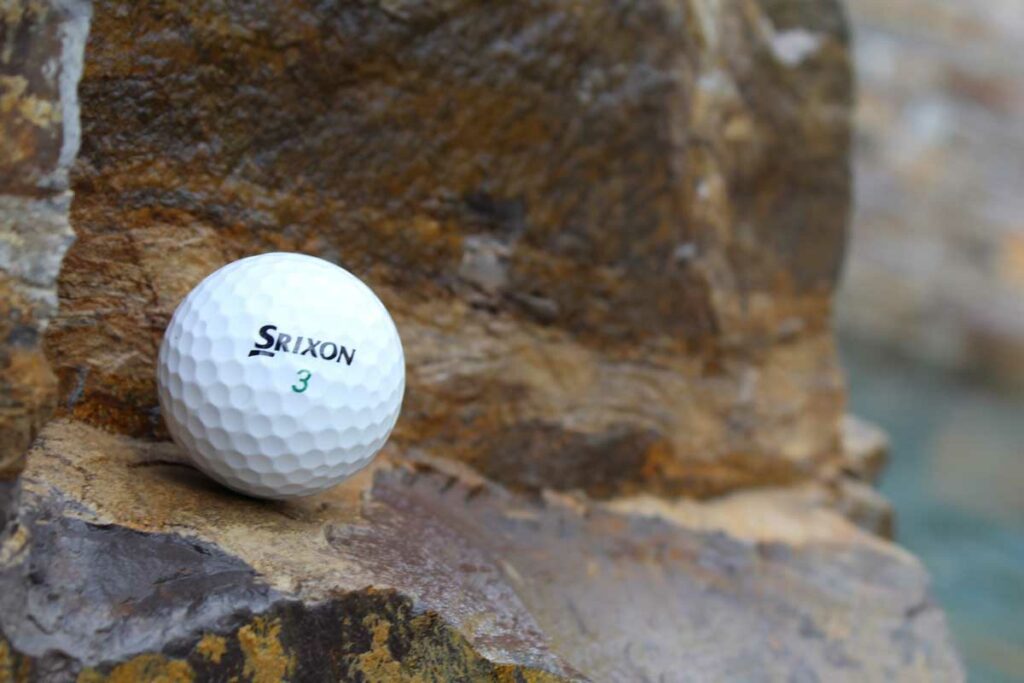
1. Srixon Z-Star
Virtually every company markets their balls as low spinning off the driver. However, there is only one that can actually be the lowest.
In my experience, that is the Srixon Z-Star.
It doesn’t quite reach the distances of other tour balls, but this low spin enables it to hold its line better than just about everything out there.
Another nice trait is, unlike most balls that don’t spin off the driver, the Z-Star actually spins quite a bit on shorter clubs.
It’s not quite to the level of a Pro V1x or Chome Soft X, but it has plenty of stopping power to trust that you can hold the green on a tough pitch or chip.
If you play in the wind a lot or have trouble leaking shots left and right, I would highly encourage you to give the Srixon Z-Star a shot.
- Good for: Golfers wanting lower spin on longer clubs.
- Construction: 3-piece
- Cover: Urethane
- Price: $48
- Solid Alternative: Titleist Pro V1, Maxfli Tour, Vice Pro
2. Srixon Z-Star XV
The Z-Star XV is the firmest of the Srixon offerings and rivals some of the firmest options out there.
Full disclosure: this is the golf ball that I have played the most in recent while occasionally switching in the Bridgestone Tour B X.
With a firmer feel, the Z-Star XV is definitely tailored toward players with higher swing speeds who desire distance a little more distance.
This Srixon offering also provides you with a little more with mid to long clubs than the Z-Star does. I say “work” as a kind way of also saying it will slice/hook way more…
Either way, I have always been drawn to its ability to hit and stop on those mid to short irons that I just don’t get with many other balls.
- Good for: Higher launch and more workability on longer shots.
- Construction: 3-piece
- Cover: Urethane
- Price: $48
- Solid Alternative: Bridgestone Tour B XS, Titleist Pro V1x
3. Srixon Z-Star Diamond
For the Brooks lovers.
The newest of the Srixon offerings is no doubt made to be a tour ball.
The firmness of the Z-Star Diamond comes in right around that of a Pro V1 but offers more in the way of spin, especially on longer iron and driver shots.
As far as short-game playability, it will play similarly to the Z-Star XV.
In my opinion, the Z-Star Diamond fits a very specific type of golfer, i.e. Brooks, and if that is you, go for it.
But if you don’t need, or want, that much more long game spin, then there are probably better options out there for you.
- Good for: Low spin players trying to add spin and distance.
- Construction: 3-piece
- Cover: Urethane
- Price: $48
- Solid Alternative: Callaway Chrome Soft X
4. Srixon Q-Star Tour
Srixon often leads with the belief that tour balls are for tour players.
They design their tour balls with specific tour needs in mind for specific players in their lineup and I think it shows through with what they deliver.
Then there are us weekend warriors. And we need golf balls too!
That’s what the Q-Star Tour is for.
It’s one of the softest urethane golf balls out there.
It is also one of the lowest-spinning balls you can buy.
If your goal is to get out on the course, keep the ball in play, and just have an all-around good time. Look no further.
*The last version of the Q-Star Tour had some known consistency issues. The ball has been completely revamped to what it is now. Time will tell if all the issues have been fixed.
- Good for: Players focused on a softer feel and keeping the ball in play.
- Construction: 3-piece
- Cover: Urethane
- Price: $35
- Solid Alternative: Titleist Tour Speed, Taylormade Tour Response
DTC Golf Ball Brands (Direct-to-Consumer)
We’ve reached the fun part.
A discussion of golf ball brands would be complete without the scrappy disruptors.
The Davids trying to take on the Goliaths.
The good news? Most of them will beat the big brands in pricing.
The bad? Creating a golf ball is about as complex as creating aerospace technology.
Literally. The patents prove it.
And the massive amounts of R&D required put these golf ball brands behind the 8-ball before they even sell a single golf ball.
However, we all know how the story of David and Goliath ends which is great news for you and the quality golf balls on this list.
Vice Golf Balls: Not Just Here to Look Cool
Somewhat of an inspiration in the golf space, Vice has somehow done the impossible.
Made golf look cool and made legit high-quality products at the same time.
Golf is no longer a ‘stuffy’ game and I think we owe a large part of that to Vice.
The part though?
They make some of the best quality golf balls while also flexing their ‘cool’ muscle.
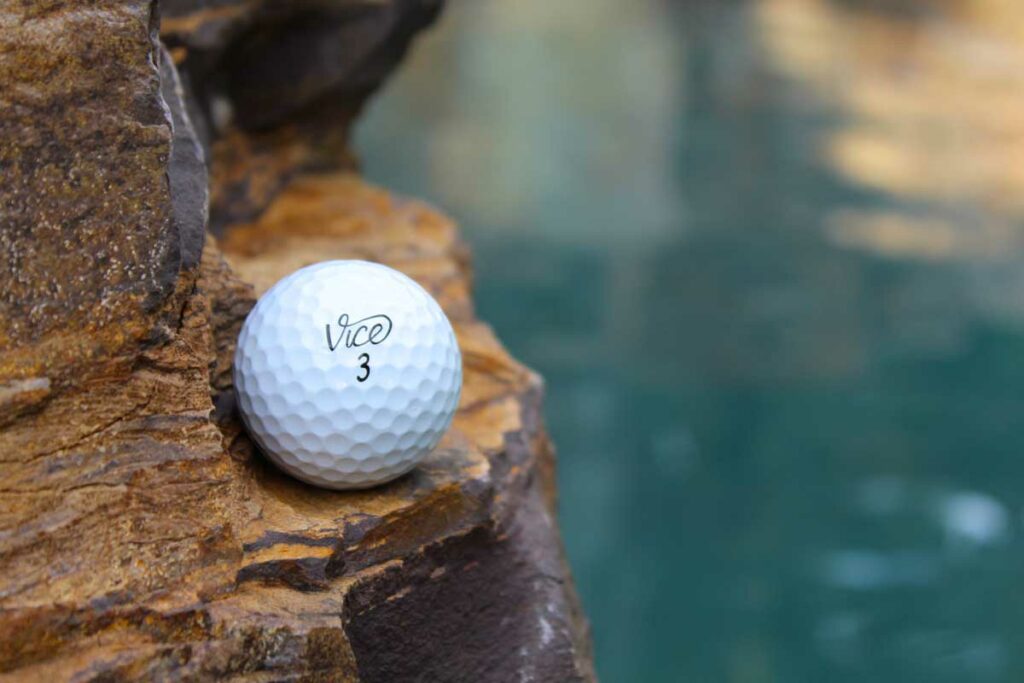
1. Vice Pro
No ifs ands or buts about it, the Vice Pro golf ball is here to go head-to-head against the Pro V1.
It won’t blow anybody away in any one performance characteristic, but it also has no weaknesses.
It stands out as a versatile option for golfers in the middle of the speed, spin, and skill spectrum.
The best part is it does all of this while firmly landing in the middle of the firmness scale among the premium tier golf balls.
Extremely high-swing speed players may not love it, but the rest of us mere mortals will regret not giving the Vice Pro a try.
- Good for: All-around performance.
- Construction: 3-piece
- Cover: Urethane
- Price: $39 w/ bulk discounts as low as $32
- Solid Alternative: Titleist Pro V1, Maxfli Tour
2. Vice Pro Plus
The Vice Pro Plus falls on the firmer side of the firmness scale. It’s not quite as firm as something like a Pro V1x, but still plays firmer than its the Vice Pro companion.
There’s no doubt the goal for the Pro Plus is maximizing distance.
It comes with a unique ability to launch high with low spin, especially the faster you can swing your driver.
With that said, the short-game spin sits close to the middle of the pack and will give you ample stopping power around the green.
The Vice Pro Plus won’t be an elite stopper around the greens, but you will be able to notice the spin.
- Good for: High-swing speed golfers who want to maximize distance.
- Construction: 4-piece
- Cover: Urethane
- Price: $39 w/ bulk discounts as low as $32
- Solid Alternative: Srixon Z-Star XV, Callaway Chrome Soft X
3. Vice Pro Soft
The most common way a golf ball gains distance is by being firmer. The firmer a golf ball (higher compression rating) the faster the ball speed.
If you look up and down this list, you’ll see that is a common theme.
However, there is another way for a ball to gain distance.
Spin less.
Though not gaining quite as much distance, if two balls are hit at the same speed with the same launch angle, the one that spins less will inevitably go farther.
This latter option is the one the Vice Pro Soft takes.
It falls well below the average firmness of any ball with a urethane cover.
The downfall of its softness means it also ranks toward the bottom when it comes to spin.
Especially around the green.
- Good for: Golfers who prefer a soft feel over all else.
- Construction: 3-piece
- Cover: Urethane
- Price: $39 w/ bulk discounts as low as $32
- Solid Alternative: Bridgestone B RXS, Callaway Chrome Soft
4. Vice Pro Zero
The discount ball’s discount ball.
Safe to say Vice is going after the discount market with this one.
When compared to other brands, you usually have to settle for an ionomer cover at this price point.
However, Vice leverages its position in the DTC space to still offer a urethane cover at wicked low prices.
Unfortunately, that’s about the end of the good news for the Pro Zero.
It’s one of the shorter balls off the tee and doesn’t spin a heck of a lot around the greens.
If budget is your main priority, it’s worth trying the Pro Zero.
If anything else is your main priority, there are better options out there.
- Good for: Golfers on a budget.
- Construction: 3-piece
- Cover: Urethane
- Price: $33 w/ bulk discounts as low as $26
- Solid Alternative: Bridgestone B RXS, Maxfli Tour S
Maxfli Golf Balls: Goliath’s David
Maybe the most shocking development in golf balls in recent years is Maxfli.
Technically a DTC ball as the only place you can buy them is the company that makes them.
That company just happens to be the big box store known as Dick’s Sporting Goods. And, by extension, Golf Galaxy.
1. Maxfli Tour
I can’t believe I’m about to say this but…
The closest comparison I can make to the Maxfli Tour is a Titleist Pro V1.
When the internet broke a few years ago comparing a Kirkland golf ball to a Pro V1, they were wrong.
This is the ball that compares to the granddaddy of them all.
I guess if you’re looking for a difference, the Maxfli Tour has fewer dimples. But when was the last time you counted the dimples on your golf ball?
The spin is almost identical from drivers all the way down to wedges.
The firmness is generally the same. The Maxfli Tour has fluctuated with its last few iterations, but the most recent one is virtually the same.
The Maxfli Tour does have a tad higher trajectory, but that was the only real difference I saw.
And it’s $15 less than a box of Pro V1s. AND! GOLF GALAXY HAS BULK BUY PROMOS ON THE REGULAR THAT SAVE ANOTHER $10 PER DOZEN!
That’s all I have to say. Go try them!
- Good for: All-around performance.
- Construction: 3-piece
- Cover: Urethane
- Price: $40
- Solid Alternative: Titleist Pro V1
2. Maxfli Tour X
The firmest ball in the Maxfli family, the Tour X rivals some of the firmest golf balls on the market. Right up there with the Chrome Soft X LS and Titleist Pro V1x Left Dash.
With that added firmness and the addition of a 4th layer, the Tour X is also the highest-spinning ball Maxfli offers. Better yet, it’s also among the highest-spinning balls from any company for wedges and short irons.
I’m not ready to jump up and down and exalt this as the closest thing to a Pro V1x, but it’s pretty close.
Unfortunately, distance is where the Tour X falls short.
But if workability and stopping power on the green is more of what you need, the Tour X is a tour-quality ball at an amateur price.
- Good for: Golfers who want workability and drop-and-stop greenside spin.
- Construction: 4-piece
- Cover: Urethane
- Price: $40
- Solid Alternative: Titleist Pro V1x
3. Maxfli Tour S
Letters on golf balls can be confusing.
In this case the “S” means soft. And if it doesn’t, it should.
The newest ball in the Maxfli lineup, it’s also the softest ball in the lineup. Not by much, however, as it’s pretty close to the Maxfli tour and it’s still reasonably close to average firmness for most other tour balls on the market.
With this extra softness, it will launch a little bit lower than the Tour or Tour X and you won’t get as much side-to-side variance on longer shots.
While tighter dispersion is nice, the Tour S is achieving this with less spin which invariably means it won’t have quite as much stopping power around the green.
However, if bump and run is your game and you like a softer feel, the Maxfli Tour S is here to compete with the big boys.
- Good for: All-around golfer who wants a softer feel.
- Construction: 3-piece
- Cover: Urethane
- Price: $40
- Solid Alternative: Callaway Chrome Soft
Snell Golf Balls: The Godfather of Modern Golf Balls
It’s safe to say Snell has a leg up on all other DTC brands.
Not because they run their business any differently, but rather because of who runs their business.
Dean Snell.
Ask anyone who knows golf balls and they know Dean.
Why?
He helped create one of the most well-known golf balls that has ever lived.
The Titleist Pro V1.
Yes, one of the original creators of one of the game’s greatest golf ball breakthroughs is off on his own now.
Stopping at some other resting places between then and now, Dean now corners a portion of the market with his own name on his golf balls.
Snell Golf has created somewhat of a cult following and for good reason.
He just wants to make good golf balls.
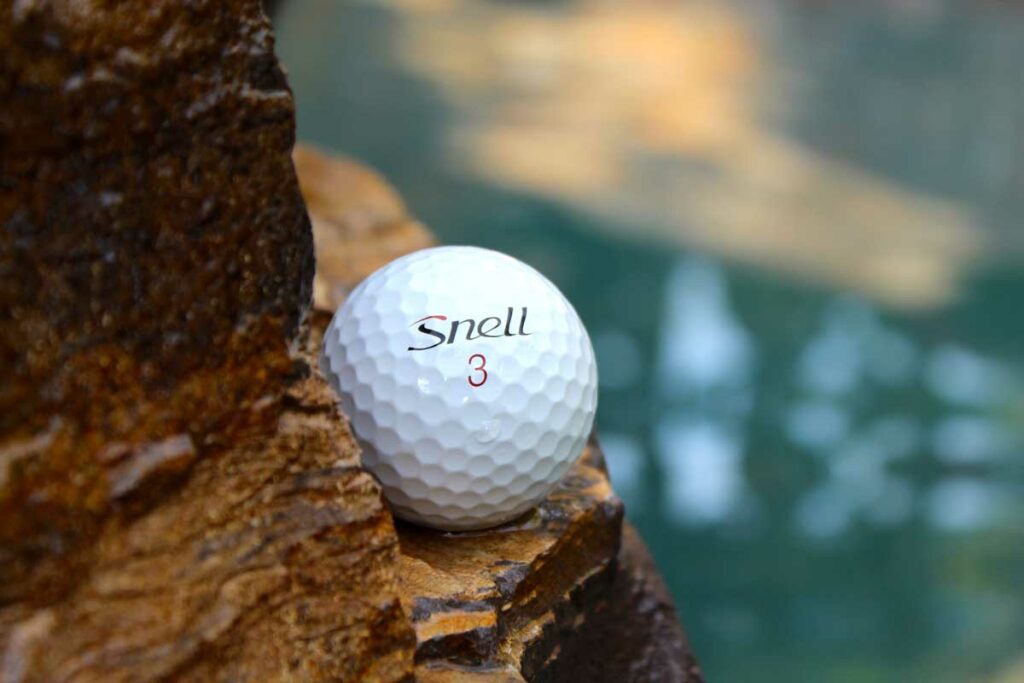
1. Snell MTB Prime
If you’re familiar with the Snell Golf lineage, the MTB Prime is replacing the MTB Black as the company’s softer option.
However, this version seems dramatically softer than previous versions.
While the feel of this ball might be exactly what you’re looking for, there have been some durability issues.
Most notably wear and tear on the cover seems to be happening at a rampant rate.
With that said, the performance piece of the puzzle is there.
The MTB Prime offers driver spin right around the average golf balls and will be a smidge higher around the greens.
It might not perform quite like the most elite of the premium balls, but it’s also $20-25 cheaper.
But again, how much do you want to chance the durability?
- Good for: All-around performance.
- Construction: 3-piece
- Cover: Urethane
- Price: $33
- Solid Alternative: Callaway Chrome Soft X, Vice Pro Plus
2. Snell MTB Prime X
On the firmer side of the Snell scale, we see the MTB Prime X replacing the MTB X golf ball.
However, just as with the Prime, the Prime X comes in dramatically softer than its predecessor.
There was a time when I played the MTB X for its insane distance gains, but it sometimes came at the price of feeling like I played with a rock.
The Prime X is undoubtedly softer and feels more in line with average compression for premium ball options.
With that said, just like the Prime, the biggest concern is durability.
None of us want to hit a ball in the bunker, but when we inevitably do, it’s nice to know that it won’t scuff our ball.
As far as performance goes, the Prime X will spin less than the Prime, so prepare for some bump-and-runs around the green.
Couple that with its higher trajectory and you are looking at some nice distance gains, though.
All in all, the performance of the Prime X is there, it’s just a matter of weighing the durability concerns.
- Good for: Golfers looking to minimize spin.
- Construction: 3-piece
- Cover: Urethane
- Price: $33
- Solid Alternative: Callaway Chrome Soft X LS, Titleist AVX
Kirkland Golf Balls: As Good as Anything Kirkland?
I don’t know if I would go that far.
But a dozen premium golf balls are gonna be tough to beat anywhere.
1. Kirkland Performance+ V3.0
Spin! Spin! And moresSpin!
The Performance+ v3.0 golf ball is the king of spin.
It spins off the driver, it spins off a wedge, it spins everywhere.
On the contrary, if you need spin, this might be the ball for you.
But we all know the real reason we are all here.
Price.
Yes, the Kirkland Performance+ v3.0 offers the best price out of any of the balls on this list and it is not a “you get what you pay for” situation.
The Kirkland ball has been notorious for breaking the interwebs when people started comparing it to a Pro V1. While I can confidently say it’s not, the gap is smaller than the price difference.
Titleist is who they are for a reason and the only thing Kirkland can dominate them on in the golf ball world is price.
Are you going to ruin your golfing experience by playing a Kirkland ball? Absolutely not. In fact, it might be fun to see what shots you can hit with a ball that spins this much.
It is an amazing ball for the average weekend warrior given the price point. But if you are serious about your game or how your golf ball performs, I would stay away from this one.
- Good for: Golfers wanting to add more spin. Or simply want to save a ton of cash!
- Construction: 3-piece
- Cover: Urethane
- Price: $18
- Solid Alternative: Taylormade TP5, Callaway Chrome Soft X
PXG Golf Balls: Extreme Disruptor?
In a matter of a few short years, PXG has seemingly gone from a top-dollar club manufacturer to a “reasonably” priced competitor.
I can’t believe I just called a $500 driver “reasonable”, but that’s a topic I’ll save for another day.
Their next mountain to climb?
Golf balls.
1. PXG Xtreme
“One ball to rule them all.”
Almost every golf ball company has at least two premium-level offerings.
Usually some combination of one firmer and one softer, one high spin and one low spin, and so on. You get the idea.
Consider PXG zigging while everyone else is zagging.
The company believes the golf ball market is too complicated and they want to simplify it.
Maybe it has something to do with Titleist offering five(!) premium-level golf balls these days.
Their goal?
Make one golf ball that spins just enough, but not too much. Make it just firm enough, but not so firm that it feels like a rock. And flies just high enough without ballooning.
In other words, make it the perfect ball for most golfers, yet it’s still playable for golfers on the high and low extremes.
It’s starting to sound oddly close to a Pro V1.
Though the PXG Xtreme might not be exactly what they intended, it still serves as a worthy competitor in the market. It also has stopping power around the greens that is only rivaled with some of the game’s most elite ‘bounce and check’ balls.
As they will tell you, they didn’t make a golf ball until they could make the best golf ball.
And it costs $15 dollars less than other OEMs!
- Good for: Golfers who want to add spin.
- Construction: 3-piece
- Cover: Urethane
- Price: $40
- Solid Alternative: Kirkland Performance+ v3, Bridgestone Tour B XS
LA Golf Ball: Beverly Hills
Not your grandpa’s golf ball company.
1. LA Golf Ball
It’s definitely early in the game for the LA Golf Ball. Aptly named.
It offers a 4-piece design with a urethane cover and a dual-core that has become increasingly rare these days.
With that, it sits right in the range of what you would expect from the most well-known dual-core ball. The Pro V1x.
Its compression hangs on the low side for similar balls and might not fit the fastest swing speeds.
However, mid-swing speed golfers will find a nice balance of moderate spin with mid-level trajectory.
There are better balls out there, but there are also a lot worse balls out there.
But hey, if you want the only ball that comes with the exclusive “Beverly Hills” stamped on the side of it, nothing is stopping you from trying it.
Well except maybe the price.
- Good For: All-around performance.
- Construction: 4-piece (Dual Core)
- Cover: Urethane
- Price: $70
- Solid Alternative: Titleist Pro V1, Maxfli Tour S
Golf Ball Brands: Final Thoughts
With this golf ball guide, you’re equipped with the knowledge to find the golf ball that best suits your game.
I want to reiterate that there is much more to the story for each of these golf balls and these snippets are just the tip of the iceberg.
Remember, the perfect golf ball varies depending on many factors in your golf game and there are often many options that will ‘fit’ your game.
You are only tasked with finding one of them.
If you need help finding the right golf ball for you, see our golf ball guide on how to test golf balls for your game.
Whether you’re seeking distance, spin control, soft feel, or versatility, there are options for every golfer.
Experiment with different brands and models during practice rounds to gain firsthand experience of how each ball performs.
Whether you’re teeing off, hitting approach shots, or working your magic around the greens, the right golf ball can make all the difference in achieving your golfing goals.
With all that said, get out there and go launch ’em!
Happy golfing!



Leave a Reply